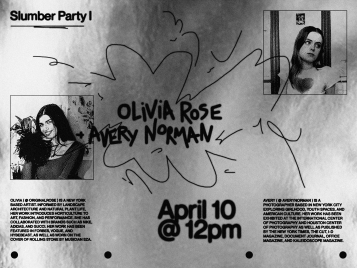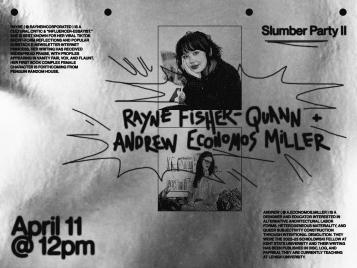Girlroom
Girlroom
Exhibition Dates
Girlroom is on view in the Banvard Gallery April 10–July 15.
To be a girl is to be a computer.
As a product of habits assembled by advanced capitalist societies, the human-technical interface of contemporary media machines has been transformed from simple tools to total environments. Digital platforms and their citizens increasingly perform as producers, consumers, and images simultaneously using the autotextual as a reflexive measure—which is, like, so totally an archetypal girl affair.
By viewing explicitly personal imagification and its consumption as a legitimate mode of production, the “girl” finds exposure within containment until all is neither exposed nor contained. Late-twentieth-century subculture discourse observed the historical, ongoing, and prospective gendered use of representational media within bedrooms to break tidy identities and procure spatial mobility within a political order that imposes austerity, and isolation. The valorization of endless artifacts and their associated myths line, fill, and adorn the fabric of the “girlroom” to corrupt its infinite smoothness until the private and locally-sited become public, multi-sited, and transnational. Through intimate collaboration with material and immaterial environments—matter and their representation—place is reinscribed and the self turned inside-out.
The girl is now neither gendered nor of a particular age—or at least not only. Instead, they are characterized as a virtual subject in boundless transit whose figural constructions render indeterminate the sticky line between fact and fiction; the past, the now, and the later or the appropriate, the abject, and the whatever. The girlroom is thus an anti-typology, rather a site for technocultural intervention and a stage of collective feminine consciousness continually revised and elaborated upon. For the girl and the computer, survival is predicated on behavioral captures and feedback loops of receiving, encoding, storing, manipulating, and distributing data and narrative from their black box of excess, augmentation, and meta-reflection. The advent of automata—decidedly pronounced in the bow-saturated “Year of the Girl”—marks an evolution in this conjoint machinic condition: the interiorized topology to which the girl and the computer were formerly purely passive recipients are increasingly actively lifted, destabilized, and dissolved.
Girlroom seeks parallels between the fragmented but relational nature of synthetic media and the girlroom. The two converge as technologies of memory and abandon through their shared formal language of clusters of symbols given meaning only as a consequence of proximities. Artificial image noise clusters and girl clusters (colloquially referred to as “girl mess” or “femmage”) interfere with and act as fields. Cluster is both a noun and a verb. The causal correlation between clusters is not stable, they leak; linger and expire, expand and contract, swell and swallow. Reciprocal intersections aggregate to evolve simulations, gaps dictate new ecologies, and idle information obfuscated without loss. Random, yet tracing highly specific intimations around which reality bends. Eras last for seconds, minutes, hours, days, weeks, and maybe months. As clusters pile up, their granular materials—literal or ideological—consume themselves to trigger the collapse of their proverbial walls. The girl and the computer have become vehicles of some contemporary default under which discrete objects are eroded through their own encasement. The lure of the subject is consequently marked by the ravages of the medium. This synchronous “malfunction" proposes potent surfaces from which further reflexivity can be extracted.
Girlroom collapses medium and subject toward immaterial and material palimpsests using multimodal artificial intelligence, visual and audio programming, and textilic manipulation. Its mechanical gestures tether historical and contemporary methods of technological labor within choreographies and aesthetics of consumption endemic to the girl. Each palimpsest is anchored in sensorial domestic narratives on isolation, mediated connection, and shared ritual, produced through a recursive procedure of sampling, composing, and decomposing disparate data. Its three composite surfaces—screen, drawing, and wall—consume, disfigure, and occupy one another at varying levels of visibility to imply a complete object entangled in the machines that give it shape. Raw-edged pixels, loose threads to threads in knots, and random access memory transfixed with pins void scalar transparency for slippery spatial interpretations. The girlroom emerges as an enduring canvas: as narrative shifts or data accumulates, its surfaces may renew their meaning.
Amongst the shrapnel of code, everything becomes girl-coded.
About the Team
Samiha Meem
2023–24 Howard E. LeFevre ’29 Emerging Practitioner Fellow
Samiha Meem is a designer, writer, and educator. Her practice and research explore “autospatial” performance, production, and consumption of images, media infrastructures, and popular culture.
- Siana Bennett (Design Development)
- Lucy Stiebel (Textile Prototyping)
- Karlie Rainer (Environment)
- Gabrielle Newman (Display)
- Anna Schneider (Object)
- Janavi Bhatt (Fabrication)
- Sydney Stuermer (Fabrication)
- Anna Galo (Fabrication)
- Sandhya Kochar (Installation)
- Michael Johnson (Installation)
Related

Girlroom Slumber Party I with Olivia Rose and Avery Norman
Apr 10, 2024
12:00pm–1:00pm
Knowlton Hall, Banvard Gallery

Girlroom Slumber Party II with Rayne Fisher-Quann and Andrew Economos Miller
Apr 11, 2024
12:00pm–1:00pm
Knowlton Hall, Banvard Gallery

